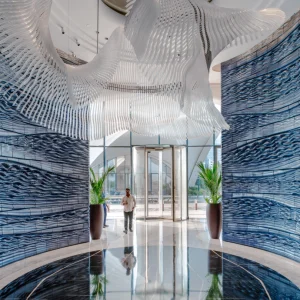WE ARE USED to smart heating, lighting and doorbells, but the acres of space beneath our feet in offices, shops and public buildings is a largely untapped area of potential – until now. ‘While not the proverbial blank canvas, flooring is certainly under-explored by architects,’ says Steve Moore, founder of SMC Smart Homes. ‘Obviously it’s already meeting multiple demands – as a structural and decorative solution as well as often incorporating acoustic and heating components, and sometimes forming a part of the fire partitioning. It’s expected to form a key part of the interior fabric throughout the life of the building, yet is almost never upgraded or modified during that time,’ he says.
 HYLO is a 28-storey office building in Islington that was transformed from an outdated 1960s towerblock into a sustainable development with 258,000ft2 of premium office space and 17,000ft2 of retail. SMC created an interactive floor for the entrance with the ability to create and add bespoke content. In this example, as visitors walk across the floor the water appears to splash with each step and the fish respond to the movement. Interactive flooring SMC ; Client CIT ; Architect HCL ; Interior design Stiff + Trevillion
HYLO is a 28-storey office building in Islington that was transformed from an outdated 1960s towerblock into a sustainable development with 258,000ft2 of premium office space and 17,000ft2 of retail. SMC created an interactive floor for the entrance with the ability to create and add bespoke content. In this example, as visitors walk across the floor the water appears to splash with each step and the fish respond to the movement. Interactive flooring SMC ; Client CIT ; Architect HCL ; Interior design Stiff + Trevillion
When it comes to technology, Moore is something of a visionary, as was recognised by his 2023 Lifetime Achievement Award from Cedia, the association for smart home professionals that he helped launch in Europe back in 1994. After reading architecture at The Bartlett, Moore was drawn into the world of new technology, spending ten years working in high-end AV before launching his own smart home company, SMC, in 1993 – the same year the World Wide Web became public. Before most people even had email, let alone broadband, he was laying the groundwork for today’s ultra-connected smart homes.
 This may look like just a beautiful staircase, but whenever someone walks up or down it creates a symphony of sound and colour – just one of the many smart home features in this 18,000ft2, six-bedroom private home in London with an indoor swimming pool, gym and car-stacking garage. The lighting and sound effects in the staircase are activated by pressure sensors recessed to the underside of the translucent Corian treads, integrated into the Lutron system for easy control. The home also has an indoor slide with interactive sound and light and a lift with video screens. Interactive flooring SMC ; Client Private home ; Architect/Interior design KSR Architects & Interior Designers ; Structural Engineers Price & Myers
This may look like just a beautiful staircase, but whenever someone walks up or down it creates a symphony of sound and colour – just one of the many smart home features in this 18,000ft2, six-bedroom private home in London with an indoor swimming pool, gym and car-stacking garage. The lighting and sound effects in the staircase are activated by pressure sensors recessed to the underside of the translucent Corian treads, integrated into the Lutron system for easy control. The home also has an indoor slide with interactive sound and light and a lift with video screens. Interactive flooring SMC ; Client Private home ; Architect/Interior design KSR Architects & Interior Designers ; Structural Engineers Price & Myers
 Floors provide ample space for being creative with lighting, as Nulty demonstrated at the Hakkasan Terrace in Abu Dhabi, where the team used linear profiles across the floor, pathways, and underneath cabanas to create a visual effect, but also to highlight circulation routes. The exterior terrace of the restaurant, in the grounds of the Emirates Palace hotel, features soft lines of white light, embedded into the stone floor surfaces to form a playful visual effect across the terrace, steps, and pathways, creating an elegant ambiance as well as improving wayfinding. Image Credit: Alex Jeffries Lighting design Nulty ; Client Hakkasan ; Architect and project manager Woods Bagot ; Interior designer Gilles & BoissierFit-out Decovision LLC
Floors provide ample space for being creative with lighting, as Nulty demonstrated at the Hakkasan Terrace in Abu Dhabi, where the team used linear profiles across the floor, pathways, and underneath cabanas to create a visual effect, but also to highlight circulation routes. The exterior terrace of the restaurant, in the grounds of the Emirates Palace hotel, features soft lines of white light, embedded into the stone floor surfaces to form a playful visual effect across the terrace, steps, and pathways, creating an elegant ambiance as well as improving wayfinding. Image Credit: Alex Jeffries Lighting design Nulty ; Client Hakkasan ; Architect and project manager Woods Bagot ; Interior designer Gilles & BoissierFit-out Decovision LLC
Moore notes that flooring offers a wide range of hightech possibilities, assisted by the fact that it presents a wide and uninterrupted area, unlike walls and ceilings that have multiple punctuations for lights, switches and other devices. Possibly the most exciting prospect is the use of flooring for generating electricity – a bill-payer’s dream that is already becoming a reality on a small scale. ‘Sprung floors have been used in ballrooms and exercise spaces for over a century, and designers have experimented with the harvesting of power using these movements for a while,’ he says. Companies including Pavegen and Energy Floors are already creating floors in high-traffic areas such as airports, museums and shopping centres, where everyday footfall can power displays and games – it’s a long way from powering an office from people strolling to the water cooler, but it’s a step in the right direction.
 Electric car charging with no trailing cables and no need to plug in is the next innovation on the horizon. Siemens and Mahle are collaborating in the field of inductive charging of electric vehicles, bringing to the market charging pads set into the floor that can repower an electric car with minimal effort. The technology could go further still, as scientists are experimenting with embedding charging strips into roads, so drivers will never need to charge.
Electric car charging with no trailing cables and no need to plug in is the next innovation on the horizon. Siemens and Mahle are collaborating in the field of inductive charging of electric vehicles, bringing to the market charging pads set into the floor that can repower an electric car with minimal effort. The technology could go further still, as scientists are experimenting with embedding charging strips into roads, so drivers will never need to charge.
 Pavegen flooring at Bank of the West in the US, powering display screens
Pavegen flooring at Bank of the West in the US, powering display screens
While these developments are still at a relatively early stage, Moore notes: ‘There are, however, some more practical power solutions coming soon to a floor near you. Various companies, including Tesla, power giant Siemens, and others, are launching underfloor and in-floor charging solutions for electric vehicles, so you don’t need to plug in. It’s similar technology to wireless mobile phone chargers but on a much larger scale.’
 Pavegen flooring in Globalworth, a mixed-use office building in Romania, powers LED lights and data screens to engage visitors
Pavegen flooring in Globalworth, a mixed-use office building in Romania, powers LED lights and data screens to engage visitors
 Pavegen flooring at Bank of the West in the US, powering display screens
Pavegen flooring at Bank of the West in the US, powering display screens
Flooring is also wide open to the possibility of integrating other systems, from lighting to video screens to smart pads that Moore says ‘allow visitors to play games, solve puzzles or otherwise engage with the environment, in a manageable, dynamic way’. SMC recently created a lift car where all surfaces were edge-to-edge screens, behind structural glass. When visitors walk into the lift, the walls, doors, ceiling and floor display high-resolution immersive video so that passengers find themselves in the Grand Canyon, an undersea world or other exciting locations. In another example, the company created a one-of-a-kind interactive staircase, made of seamless white Corian elements, where each step changes colour and plays musical notes when someone walks up or down it – evidently a huge hit at parties!
 Pavegen flooring in a gold-winning garden by Kate Gould at Chelsea Flower Show, commissioned by London retail association New West End Company. The flooring powers lighting and a fan
Pavegen flooring in a gold-winning garden by Kate Gould at Chelsea Flower Show, commissioned by London retail association New West End Company. The flooring powers lighting and a fan
 For some it might be the stuff of nightmares, but SMC created a lift car where all surfaces were edge-toedge screens, behind structural glass. When visitors walk into the lift, the walls, doors, ceiling and floor display high-resolution immersive video
For some it might be the stuff of nightmares, but SMC created a lift car where all surfaces were edge-toedge screens, behind structural glass. When visitors walk into the lift, the walls, doors, ceiling and floor display high-resolution immersive video
The prospect of intelligent flooring that can sense when it is being walked on may sound a little sinister, but has some interesting applications – and not just for security. ‘At an important, yet seemingly prosaic level, underfloor heating companies are incorporating presence sensing so that heating is turned off when not needed,’ says Moore. Healthcare settings could also benefit hugely from a roll-out of such technology. Care homes already rely on portable bedside mats to alert them when a frail resident gets up in the night, while some hospitals use GaitRite footstep-sensing walkways to analyse how steady patients are on their feet and calculate their fall risk. SensFloor, however, takes it a step further, with intelligent sensors that can be fitted beneath any standard flooring, turning lino or carpet tiles into a smart floor that can detect movement, alert staff to falls and even draw attention to health issues if a person begins to walk more slowly or unsteadily.
 SensFloor is an invisible smart system that can be laid under regular flooring and identifies walking patterns. It can be used in care settings to monitor health issues that affect walking, and sounds an alarm in the event of a fall. It can also be used in retail environments to track shopping activity. Image Credit: Future-Shape Gmbh
SensFloor is an invisible smart system that can be laid under regular flooring and identifies walking patterns. It can be used in care settings to monitor health issues that affect walking, and sounds an alarm in the event of a fall. It can also be used in retail environments to track shopping activity. Image Credit: Future-Shape Gmbh
In 2023, the smart flooring market was worth around £182m, according to Fortune Business Insights, with an estimated value of £4.6bn by 2030, so we can expect to see the technology becoming mainstream in the next few years.





